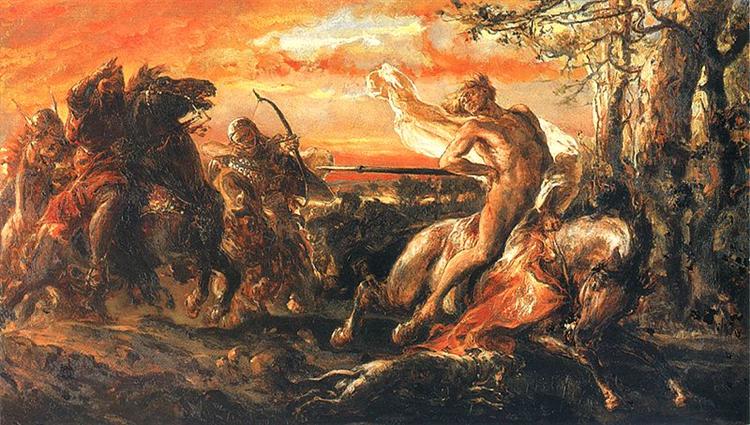Description
The work "The death of Leszek the White", painted by Jan Matejko in 1880, is a deep and moving example of the narrative talent and the compositional mastery of this outstanding Polish artist. Matejko is known for his historical representations and his ability to capture the essence of significant moments in the history of Poland. In this painting, the viewer is taken to a dramatic scene in which personal tragedy and national destiny, distinctive characteristics of his work are intertwined.
The composition of the painting is remarkably dynamic, centered around Leszek's fallen body, a 21st century Polish duke. The figure, resting in a colorful and vibrant background, is surrounded by several characters that react to the imminent outcome. Matejko manages to transmit a deep empathy through the facial expressions and body mobility of the characters; Each is immersed in their own emotion, be it sadness, despair or impotence before the leader's death. This representation of the crowd, a recurring feature in the works of Matejko, enriches the narrative, symbolizing the connection of the individual with the collective, both personal and nationally.
The use of color in paint is one of the most intriguing dimensions of the work. Matejko uses a rich and deep palette, where the terrible and blue tones predominate that suggest both the seriousness of the situation and an immediate contrast with the life and vitality that these characters could represent in another context. The target of the mantle that surrounds Leszek becomes a symbol of his nobility and the purity of his figure, attracting the viewer's gaze towards the unfortunate leader. This color game not only supports visual narration, but also invites a reflection on the leader's legacy and the impact of his death on the history of Poland.
In the background, elements that evoke an atmosphere of tragic and noble history can be discerned. Although the painting focuses on Leszek's death, Matejko does not forget to include symbols of his time and place, such as the characteristic architecture of medieval Poland, which properly frames the events that are being developed. The attention to detail in the suits and weapons of the companions reveals the remarkable historical research that Matejko carried out before each work, a feature that gave him recognition as one of the masters of Polish romanticism.
In addition, it is important to note that Jan Matejko is considered a pioneer in the representation of historical art in Poland, and his work on the death of Leszek El Blanca can be seen in continuity with his series of works that explore crucial moments of Polish history, such as "the battle of Grunwald" and "The trial of the princess".
"The death of Leszek el Blanco" is, in short, more than a simple portrait of a tragic scene; It is a work that encapsulates the greatness of the Polish past and the collective suffering that accompanies its history. Through his artistic ingenuity and his moving visual narrative, Matejko not only illustrates a particular moment, but also invites the viewer to meditate on memory, sacrifice and the lasting impact of leaders in the history of their peoples. This work thus becomes an icon, both of Matejko's technical ability and its commitment to Polish history and identity.
KUADROS ©, a famous paint on your wall.
Hand-made oil painting reproductions, with the quality of professional artists and the distinctive seal of KUADROS ©.
Art reproduction service with satisfaction guarantee. If you are not completely satisfied with the replica of your painting, we refund your money 100%.

